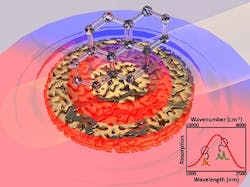Nanoporous gold disks could sense hydrocarbons for downhole fluid analysis
Researchers from the University of Houston (UH; Houston, TX) have reported a new plasmonic surface-enhanced near-infrared absorption (SENIRA) technique to determine the chemical composition of materials using near-IR light.1 This development allows substances that can't be accurately measured by sensors operating in the near-IR to be studied in far more detail than that provided by current techniques in the near-IR.
The work could have a number of potential applications, including improving downhole drilling analysis in the oil and gas industry and broadening the spectrum of solar light that can be harvested and converted to electricity, says Wei-Chuan Shih, associate professor of electrical and computer engineering at UH.
IR spectroscopy is an important tool for scanning and identifying the chemical composition of organic, polymeric, and some inorganic materials, but it has limitations. Much of the IR spectral region is absorbed by water, so these wavelengths can't be used with water-based samples. While near-IR light scanning is compatible with water, current techniques are less sensitive than those using other wavelengths.
The UH approach obtains both chemical and refractive index at the same time using 1 to 2.5 µm near-IR light. The technique relies on nanoporous gold disks, which have high-density plasmonic hot-spots of localized electric field enhancement for high-sensitivity chemical detection, according to the researchers.
Sensitivity increased 10,000-fold
Shih says working with near-IR light is usually a double-edged sword, as it can be used with water-based samples but doesn’t provide the needed detail. "We showed water is not an issue, but we can also increase the sensitivity of what we want to measure by 10,000 times," he notes.
He and members of his lab have worked with nanoporous gold disks since discovering the structure in 2013. For this project, he says they tuned the nanodisks to react when exposed to specific wavelengths, making it possible to develop a sensing technique with the advantages of both IR and near-IR scanning.
The technique was tested with various crude oil and other hydrocarbon samples, and Shih says it could be used in downhole fluid analysis, which uses near-IR spectroscopy to analyze material found deep in a well. The technique allows drillers to know quickly what is below the ground or seabed, but he says the new technique could simplify the process because it requires a smaller sample for analysis.
Oliver C. Mullins, a scientific advisor at Schlumberger (also in Houston) and the primary originator of downhole fluid analysis, said the discovery holds potential for both the lab and the field.
"Optical spectroscopy has made significant contributions in the oil and gas industry beyond laboratory characterization," he says. "In particular, in-situ fluid analysis in oil wells based on vibrational overtones and electronic absorption in the visible and near-infrared wavelengths has become an industry standard in wireline well logging. SENIRA brings in an exciting prospect for potential better sensor technology in both field and laboratory settings."
Although the paper uses hydrocarbon composition analysis as an example of how the technique could be deployed, Shih says it can be applied to any molecular species.
REFERENCE:
1. Wei-Chuan Shih et al., Nano Letters (2016); doi: 10.1021/acs.nanolett.6b01959
About the Author
John Wallace
Senior Technical Editor (1998-2022)
John Wallace was with Laser Focus World for nearly 25 years, retiring in late June 2022. He obtained a bachelor's degree in mechanical engineering and physics at Rutgers University and a master's in optical engineering at the University of Rochester. Before becoming an editor, John worked as an engineer at RCA, Exxon, Eastman Kodak, and GCA Corporation.

